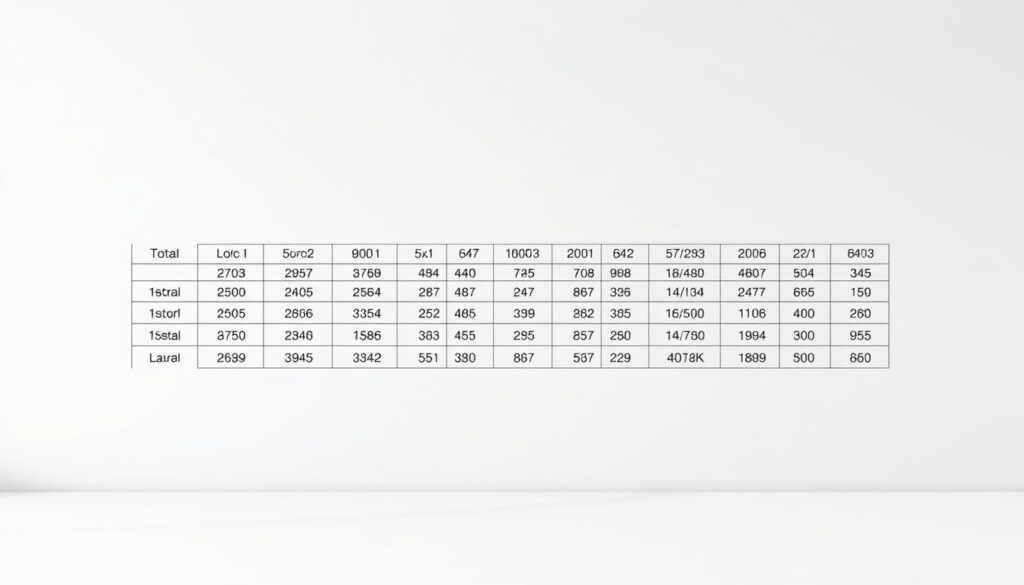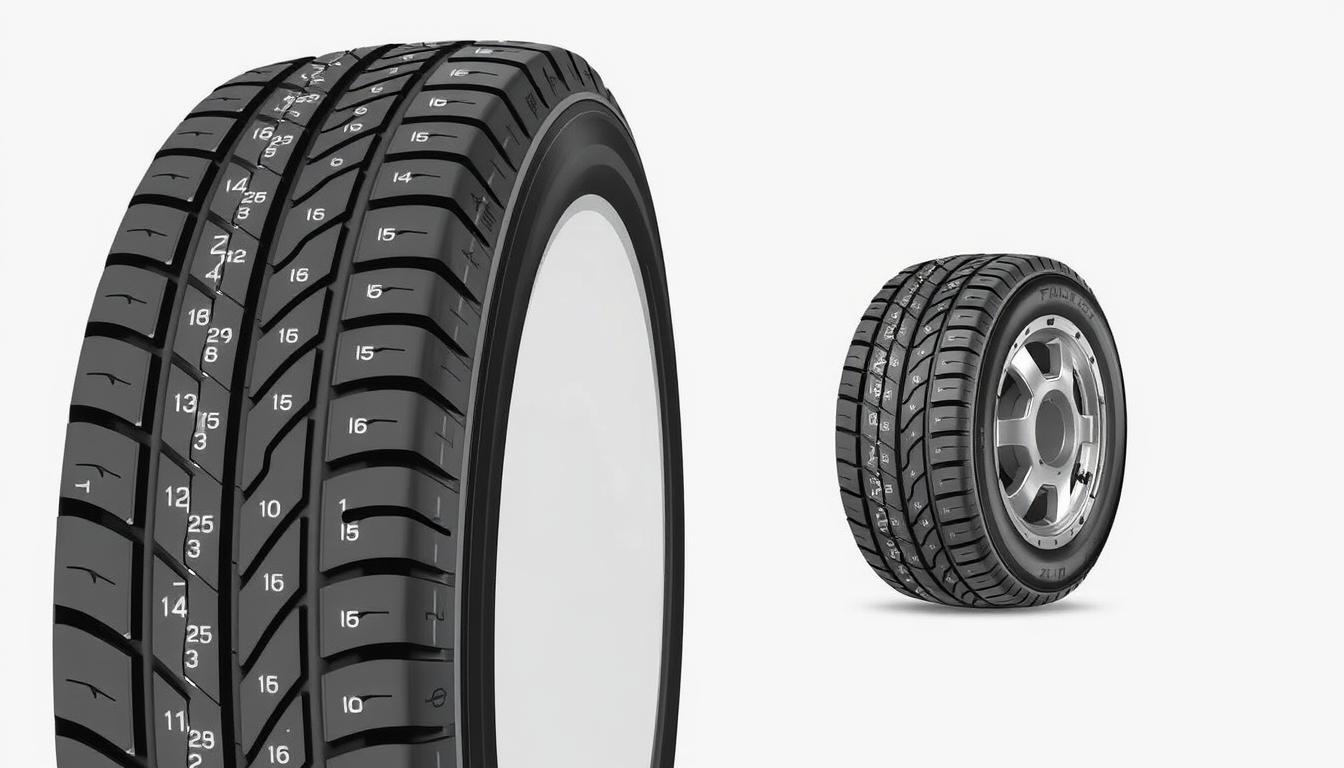Did you know the numbers and letters on your tire’s sidewall are key? They tell you about its capabilities and limits. The tire size designation is not random. It’s a code that shows the tire type and width, aspect ratio, construction type, diameter, load index, and speed rating.
We’ll explain what each part of this code means. It’s important for car owners to know this. It ensures their vehicle’s safety and performance.
Key Takeaways
- Understanding tire numbers is key for vehicle safety and performance.
- The tire size designation code includes info on tire type, width, and more.
- Decoding tire numbers helps car owners make informed choices.
- Knowing the load index and speed rating is vital for safe driving.
- Proper tire understanding can improve your driving experience.
Why Tire Numbers Matter for Your Safety and Performance
Tire numbers are more than just digits. They are key to keeping your vehicle safe and running well. They tell you about the tire’s size, how much it can carry, and its speed and wear ratings. Knowing this info is key to keeping your vehicle safe.
Safety Implications of Correct Tire Specifications
It’s critical to pick the right tires for safety. The load index and speed rating are very important. They make sure your vehicle can carry its weight and go the right speed safely. Using tires that are too light can cause them to fail, which is dangerous when you’re carrying heavy loads or towing.
“The right tires can make all the difference in ensuring your vehicle’s safety on the road. It’s not just about size; it’s about the specifications that match your vehicle’s requirements.”
Also, the right tires affect how your vehicle handles and stops. Tires that don’t match your vehicle’s speed can cause problems. They can make it harder to stop and lead to accidents.
| Tire Specification | Safety Implication |
|---|---|
| Load Index | Ensures the tire can support the vehicle’s weight |
| Speed Rating | Ensures the tire can handle the vehicle’s maximum speed |
Performance Benefits of Knowing Your Tire Numbers
Knowing your tire numbers can also boost your vehicle’s performance. By knowing the right size, load index, and speed rating, you can improve how your vehicle handles, accelerates, and brakes. This knowledge helps you choose the best tires for better performance.
- Improved handling and stability
- Enhanced braking performance
- Better fuel efficiency due to reduced rolling resistance
For example, the right aspect ratio and construction type can greatly affect your vehicle’s performance. A lower aspect ratio can make handling better, while a higher aspect ratio can give a smoother ride.
The Complete Meaning of Tire Numbers and What They Tell You
When you look at your tire, you see numbers and letters. But have you ever wondered what they mean? The tire sidewall is full of important information. Knowing this helps keep you safe on the road and makes choosing the right maintenance easier.
Overview of the Tire Sidewall Information
The tire sidewall has codes and numbers that might seem confusing. But each part tells you something important about the tire. This includes size, load index, speed rating, and more. Let’s look at what each part means.
The tire size is key. It shows the tire’s dimensions. For example, “225/45R17” means the tire is 225mm wide, 45% as tall as it is wide, and fits a 17-inch wheel. The “R” means it’s a radial tire.
Why Manufacturers Include These Numbers
Manufacturers put these numbers on the tire for your safety and performance. They give you important details about the tire’s limits. Knowing what these numbers mean helps you choose the right tires for your vehicle.
Also, having the right tire specs keeps your vehicle’s warranty valid. It ensures you follow the law and helps when you need to replace tires. This way, you pick the correct size and type for your vehicle.
Tire Size Designation: Breaking Down the P-Metric System
The P-metric system gives you a lot of info at a glance. It’s key to knowing your vehicle’s tire dimensions and what they can do. Let’s look at what each part of the tire size means.
Prefix Letters (P, LT, ST, T) and Their Meanings
The tire size starts with a letter that shows its use. “P” is for cars, “LT” for light trucks, “ST” for special trailers, and “T” for spares. Knowing these letters helps pick the right tire for your car.
| Prefix | Application |
|---|---|
| P | Passenger Vehicle |
| LT | Light Truck |
| ST | Special Trailer |
| T | Temporary/Spare |
Section Width and Aspect Ratio Explained
The next number (like 225 in P225/60R16) shows the tire’s width in millimeters. It’s the distance from one sidewall to the other. The number after the slash (like 60) is the aspect ratio. It’s the tire’s height as a percentage of its width. So, in our example, the height is 60% of the width.
Construction Type and Wheel Diameter
The “R” means the tire is radially built, which is common today. The number after (like 16) is the wheel size in inches. So, P225/60R16 fits a 16-inch wheel.
Knowing these parts of the tire size helps you pick the right tires. It makes your car safer and perform better.
Load Index and Speed Rating: Decoding Performance Indicators

Tire specs, like load index and speed rating, are key for your car’s safety. They show how much weight a tire can handle and its top speed.
Understanding the Load Index Chart
The load index is a number that shows the max weight a tire can carry. A load index of 91 means it can handle up to 615 kg or 1,356 lbs. Always check your car’s manual for the right load index for your tires.
Speed Rating Letters and Their Maximum Speeds
Speed ratings are shown by letters (like Q, R, S, T, H, V, W, Y). They tell you the max speed a tire can go for a long time. For example, an ‘H’ rated tire goes up to 130 mph (210 km/h). A ‘Y’ rated tire can go up to 186 mph (300 km/h). Knowing these helps pick the right tires for your car and driving style.
Why These Ratings Matter for Your Vehicle
Load index and speed rating are vital for your car’s safety and how well it performs. Using tires with the wrong load index can cause problems like bad traction and tire failure. Not checking the speed rating can lead to tire blowouts at high speeds. Always check these ratings when picking new tires to make sure they fit your car and driving needs.
DOT Code: Manufacturing Date and Plant Information
The DOT code on your tire’s sidewall tells you a lot about its age. It’s key information that shows when and where it was made.
Locating the DOT Code on Your Tire
The DOT code is on the sidewall, near the rim. It starts with “DOT” and has letters and numbers. Look closely to find it.
How to Read Manufacturing Date Codes
The last four digits of the DOT code show the manufacturing date. The first two digits are the week, and the last two are the year. For instance, “3219” means it was made in the 32nd week of 2019.
Why Tire Age Matters for Safety
Tire age is very important for safety. Tires get worse over time, even if they look fine. It’s best to check the manufacturing date and replace old tires.
UTQG Ratings: Treadwear, Traction, and Temperature Grades
Learning about UTQG ratings can really help you understand your car’s tires better. UTQG stands for Uniform Tire Quality Grade. It’s a set of standards that tell you a lot about a tire’s performance and how long it will last.
Longevity Expectations through Treadwear Rating
The treadwear rating shows how long a tire is expected to last. It compares wear rates, with higher numbers meaning longer life. For example, a tire with a treadwear grade of 400 will last twice as long as one with a grade of 200, under the same conditions.
| Treadwear Grade | Expected Longevity |
|---|---|
| 200 | Baseline |
| 400 | Twice as long as 200 |
| 600 | Three times as long as 200 |
Traction Grades and Stopping Performance
Traction grades show how well a tire can stop on wet roads. They range from AA (best) to C (worst). AA means the tire stops the best, which is key for safety, helping drivers stay safe in bad weather.
“Tires with higher traction grades can significantly reduce stopping distances on wet roads, making driving safer.” –
Temperature Resistance Ratings
Temperature resistance ratings are labeled A, B, or C. They show how well a tire handles heat. An ‘A’ rating means the tire can handle the hottest temperatures, while ‘C’ is the lowest. This is important for drivers who often drive fast or live in hot places.
Knowing about UTQG ratings helps you make better choices for your tires. It improves both how well they perform and how safe they are. By looking at treadwear, traction, and temperature resistance, you can pick the best tires for your needs.
Maximum Pressure and Load Specifications
Knowing the maximum pressure and load specs of your tires is key for your vehicle’s safety and performance. These specs help ensure your tires are at the right pressure and can handle your vehicle’s weight.
Finding Maximum Pressure Ratings
The maximum pressure rating is on the tire’s sidewall. It’s in pounds per square inch (PSI) and shows the highest safe pressure. Look for “Maximum Inflation Pressure” on the sidewall to find this info.
Understanding Maximum Load Capacity
The maximum load capacity is the heaviest weight a tire can carry when fully inflated. Knowing this is important to avoid overloading, which can cause tire failure. The load capacity is shown by a load index number on the sidewall.
| Load Index | Maximum Load Capacity (lbs) |
|---|---|
| 80 | 992 |
| 85 | 1135 |
| 90 | 1323 |
Optimal Pressure vs. Maximum Pressure
It’s important to know the difference between maximum and optimal pressure for your tires. Maximum pressure is the highest a tire can handle, while optimal pressure is the best for safety, performance, and fuel efficiency. Check your owner’s manual or the driver’s side doorjamb for the optimal pressure.
Keeping your tires at the optimal pressure is vital. Overinflating can reduce traction and increase tire damage risk. Underinflating can lead to uneven wear and a higher risk of tire failure.
Additional Tire Markings and Symbols

Tire sidewalls have many markings and symbols. They give insights into the tire’s specs and what it can do. These markings are key to knowing how the tire performs, its safety features, and if it’s good for different driving conditions.
M+S and All-Season Designations
Many tires have the “M+S” or “M/S” marking. It means the tire is good for driving in mud and snow. All-season tires often have this mark, showing they can handle various road conditions all year.
The Tire and Rubber Association of Canada says “M+S tires” are made for driving on different surfaces. But, it’s important to know that M+S doesn’t mean the tire is ready for very snowy conditions.
- M+S tires are good for driving in many conditions.
- They balance traction, handling, and durability well.
- Not all M+S tires are the same; quality can vary.
Severe Snow Service Rating (Mountain Snowflake Symbol)
For tires made for very snowy conditions, look for the Three-Peak Mountain Snowflake symbol. This symbol means the tire has passed tough snow traction tests and meets standards for severe snow service.
| Symbol | Description | Significance |
|---|---|---|
| Three-Peak Mountain Snowflake | Symbol indicating severe snow service capability | Passed snow traction testing; suitable for severe winter conditions |
| M+S | Mud and Snow designation | Indicates capability in muddy and snowy conditions |
Run-Flat Indicators and Technology Markings
Some tires have run-flat technology, letting you drive even after a puncture. These tires are marked with “RFT” or “Run-Flat.” Knowing these markings is key for drivers who need this feature for safety and convenience.
Consumer Reports says run-flat tires can be a big help in emergencies. But, they might not be as comfortable or fuel-efficient. It’s important to think about these trade-offs when choosing tires with run-flat tech.
Internal Construction Indicators
Tires also have markings for their internal design, like “Tubeless” or “TL” for tubeless tires. There are also “Treadwear Indicators” that show when the tread is worn down. Knowing these markings helps you understand the tire’s design and what it can do.
By learning about these tire markings and symbols, you can make better choices for your tires. This ensures your vehicle has the right tires for your driving needs.
European vs. American Tire Number Systems
Tire specs vary between Europe and America, affecting safety and performance. Knowing these differences is key when dealing with tires from different places.
Metric Sizing System Differences
The metric system is used worldwide, but there are unique ways to show tire sizes. European sizes include width, aspect ratio, and rim diameter in millimeters. American sizes mix metric and imperial units.
- European tire sizes are typically represented as: 225/45 R17
- American tire sizes might be represented as: 35×12.5 R17
These differences can cause confusion when buying tires or wheels for vehicles from other regions.
E-Mark and ECE Approval Numbers
European tires have an E-mark for safety standards. The ECE approval number also shows they meet certain rules.
These marks are important to ensure tires sold in Europe are safe and meet standards.
Converting Between Different Tire Size Systems
Converting between European and American tire sizes needs a grasp of different units. Tools and charts help with these conversions, making sure you find the right tire size.
- Identify the tire size on your vehicle’s placard or on the tire itself.
- Use a tire size conversion chart to find the equivalent size in the other system.
- Verify that the converted size matches your vehicle’s specifications.
Understanding the differences in European and American tire numbering systems helps you make better choices when buying tires or keeping your vehicle in top shape.
Common Mistakes When Reading Tire Numbers
Understanding tire numbers is key for your safety on the road. But, it’s easy to make mistakes. Many drivers don’t realize they’re misreading their tires, which can cause safety issues and affect how well the car performs. We’ll look at some common mistakes and how to avoid them.
Confusing Load Index with Pressure Ratings
One mistake is mixing up the load index with pressure ratings. The load index shows the tire’s maximum weight capacity. The pressure rating is about the air pressure the tire should have. Getting these mixed up can lead to tires not being inflated right, which is dangerous.
| Load Index | Maximum Load (lbs) | Pressure Rating (PSI) |
|---|---|---|
| 91 | 1,356 | 35 |
| 95 | 1,521 | 40 |
| 100 | 1,764 | 45 |
Misinterpreting Manufacturing Dates
Another mistake is not understanding the manufacturing date codes on tires. The code is a four-digit number showing the week and year it was made. For example, “3219” means it was made in the 32nd week of 2019. Not getting this right can mean using tires too long.
Overlooking Critical Safety Information
Many drivers miss important safety info on their tires, like the speed rating and load capacity. Not paying attention to these can make the car perform poorly and increase the risk of tire failure.
- Speed Rating: Shows the max speed a tire can handle.
- Load Capacity: Tells the max weight a tire can carry.
Using Incorrect Tire Sizes for Your Vehicle
Using the wrong tire size can really hurt your car’s performance and safety. Always check your car’s owner’s manual or the tire info placard on the driver’s side doorjamb for the right size.
Knowing these common mistakes and how to avoid them can help keep your tires in good shape. This improves both safety and how well your car performs.
Conclusion: Using Tire Number Knowledge for Better Maintenance and Safety
Knowing your tire numbers is essential for better tire care and safety. By understanding the numbers on your tires, you can keep your vehicle running well and safely. This knowledge helps you make smart choices about your tires.
We’ve looked at what each part of the tire number means. This includes tire size, load index, and speed rating. With this info, you can pick the right tires for your car and avoid safety risks.
Using tire number knowledge can make your tires safer and easier to maintain. Checking your tire numbers regularly can prevent problems. This ensures a safer and smoother drive. We urge you to use this knowledge to improve your tire care and safety.
FAQ
What do the numbers on my tire’s sidewall mean?
The numbers on your tire’s sidewall tell you important details. They show the tire’s size, how much weight it can hold, its speed limit, and when it was made.
Why is it important to understand tire numbers?
Knowing your tire numbers is key for your car’s safety and performance. It makes sure you’re using the right tires for your vehicle.
What is the P-metric system, and how does it relate to tire size?
The P-metric system is a way to show tire size. It includes a letter, width, aspect ratio, construction, and wheel size.
How do I read the load index and speed rating on my tire?
The load index is a number that shows the tire’s weight limit. The speed rating is a letter for the tire’s top speed.
What is the DOT code, and how do I locate it on my tire?
The DOT code is on your tire’s sidewall. It tells you when and where the tire was made.
What do UTQG ratings represent, and why are they important?
UTQG ratings show a tire’s wear, traction, and heat resistance. They help you know how well the tire performs and lasts.
How do I find the maximum pressure and load specifications for my tire?
Look on your tire’s sidewall for the max pressure and load specs. It’s important to know the difference between the best and max pressure.
What do additional tire markings, such as M+S and run-flat indicators, mean?
Extra tire markings tell you about the tire’s features. They show if it’s good for mud and snow or if it can support a car even after a flat.
Are tire numbering systems different for European and American tires?
Yes, European and American tires have different systems. This includes metric sizing, E-mark, and ECE approval numbers.
What are some common mistakes to avoid when reading tire numbers?
Don’t mix up load index with pressure ratings. Also, don’t miss the manufacturing date or overlook safety info. And make sure you use the right tire sizes.
How can understanding tire numbers improve my vehicle’s maintenance and safety?
Knowing tire numbers helps you make better choices. It ensures your car runs well and safely on the road.
What is the significance of tire age, and how can I determine my tire’s age?
Tire age is key for safety. Older tires might fail more easily. You can find your tire’s age by looking at the DOT code on the sidewall.
Can I use tires with different speed ratings on my vehicle?
It’s not a good idea to mix tires with different speed ratings. It can hurt your car’s performance and safety.
How do I convert between different tire size systems?
To switch between size systems, you need to know the different ways of measuring. This includes the P-metric system and the metric system used in Europe.
Recent Posts
Cold-Weather Driving Essentials: Top Gloves for Safe Winter Travel
Keep your hands warm and your steering wheel secure this winter with our top glove picks. Discover the best options for safe and comfortable cold-weather driving!
Tesla Roof Rack Storage: Ultimate Guide to Secure and Versatile Cargo Solutions
Tesla roof rack storage offers extra space to carry luggage and gear securely on your Model Y. These racks fit various needs, from bikes to kayaks, making travel easier. ...


